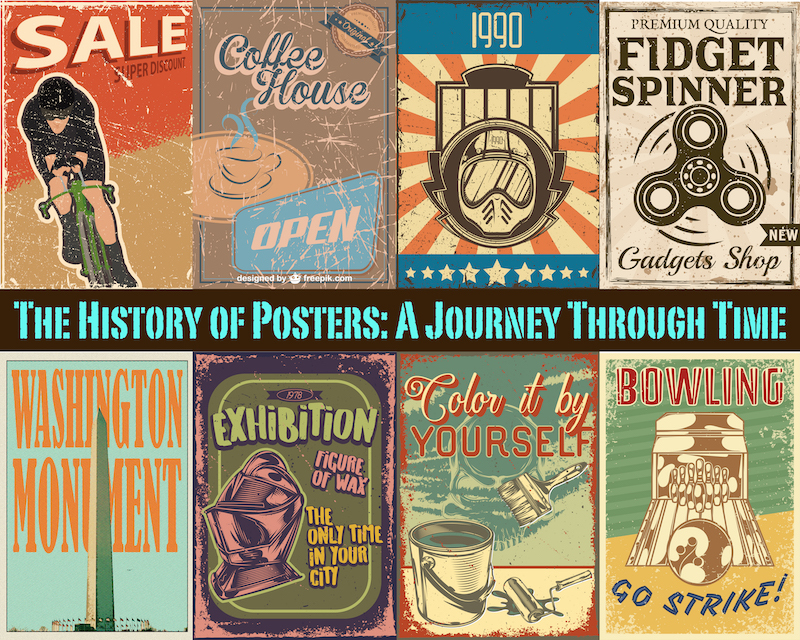The History of Posters: A Journey Through Time
-

- 23 Apr 2024

The History of Posters:
A Journey Through Time
The history of posters is a rich tapestry woven with creativity, innovation, and cultural significance. From their humble beginnings in the late 19th century to their evolution into a powerful medium of communication in the digital age, posters have both reflected and shaped the societies in which they emerged. This article embarks on a journey through time, exploring the various eras and phases of poster design, from the vibrant Art Nouveau creations of the Belle Époque to the sleek modernism of the postwar period.
Join us as we delve into the fascinating history of posters and uncover the stories they tell about the world around us.
Late 19th Century: The Emergence of the Poster
During the late 19th century, a new form of advertising and art captured the imagination of America and Paris: the color advertising poster. This period, spanning from 1890 to 1909, marked the rise of Jules Chéret as the pioneer of poster art. Chéret, often referred to as the father of the poster, perfected the lithographic process and created over a thousand vibrant designs that adorned the streets of Paris. His work symbolised the Belle Époque, a time of cultural flourishing and artistic innovation characterised by landmarks like the Moulin Rouge and the Folies-Bergère.
- Jules Chéret's "Moulin Rouge – La Goulue" (1891)
- Alphonse Mucha's "Job Cigarettes" (1896)
Early 20th Century: Art Nouveau and the Belle Époque
In the early 20th century, the Art Nouveau movement dominated poster design, characterised by its flowing lines and organic forms. Artists like Alphonse Mucha and Henri de Toulouse-Lautrec produced iconic posters that captured the spirit of the Belle Époque. These posters not only served as advertisements but also as collectible works of art, reflecting the optimism and extravagance of the era.
- Alphonse Mucha's "Sarah Bernhardt as Medea" (1898)
- Henri de Toulouse-Lautrec's "Moulin Rouge: La Goulue" (1891)
Interwar Period: Art Deco and Modernism
Following World War I, the Art Deco movement emerged, characterised by its bold geometric shapes and modern aesthetic. Posters from this period reflected a desire for progress and sophistication, mirroring the optimism of the Roaring Twenties. Governments also utilised posters for propaganda during World War II, highlighting their power as a medium of communication and persuasion.
- A.M. Cassandre's "Dubonnet" (1932)
- Edward McKnight Kauffer's "Daily Herald" (1919)
Postwar Period: Consumerism and Mass Media
In the postwar period, consumer culture and mass media influenced poster design. While Art Deco influences persisted, posters began featuring softer colour palettes and streamlined imagery. Posters advertised a wide range of products and events, reflecting the growing influence of advertising in everyday life.
- Saul Bass's "Vertigo" movie poster (1958)
- Tom Eckersley's "Keep Britain Tidy" (1958)
Contemporary Era: Digital Revolution and Beyond
In the contemporary era, the digital revolution transformed poster design, opening up new possibilities for creativity and innovation. Despite the rise of digital media, posters remain a powerful and enduring medium, capable of capturing the imagination and sparking conversation in an ever-changing world.
- Milton Glaser's "I Love New York" (1977)
- Shepard Fairey's "Hope" (2008)
Summary
Throughout history, posters have served as reflections of society, capturing the spirit of their time and shaping the way we see the world. From the elegant curves of Art Nouveau to the bold geometries of Art Deco, each era has left its mark on poster design, offering a window into the past and a glimpse of what is yet to come.
In conclusion, the history of posters is not merely a chronicle of artistic trends, but a testament to the enduring power of visual communication. From the colourful streets of 19th-century Paris to the digital landscapes of the 21st century, posters have remained a vital medium for capturing the spirit of their time and shaping cultural narratives. As we reflect on the evolution of poster design, we are reminded of the profound impact these images have had on society, both past and present, and the timeless allure of their message.
If you enjoyed this article, you may also like…
Poster Frames 101: Everything You Need to Know










